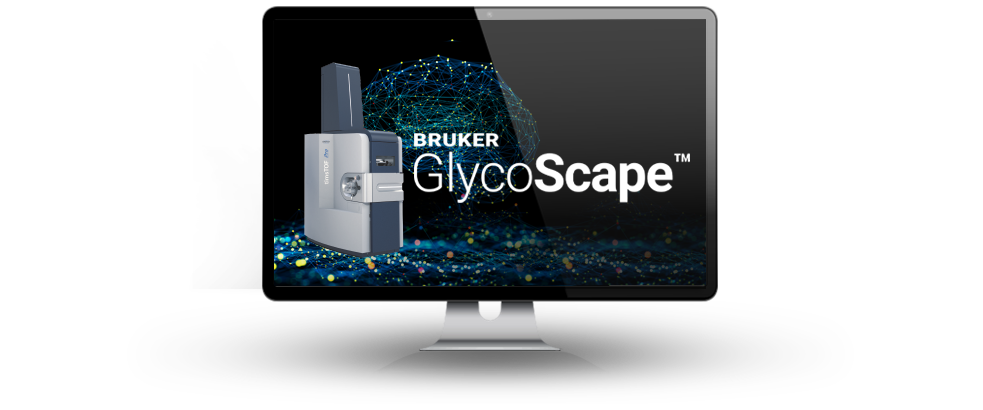GlycoScape™
Immediate Results!
Real-time results = efficiency


Real-time results to inform you of current instrument and sample status
4D-Glycoproteomics with real-time search results and smart data acquisition
Overcome the data analysis bottlenecks by integrating real-time glycopeptide identification and smart data acquisition provided by GlycoScape™.
Universally available
All current and future timsTOF Pro, timsTOF HT, timsTOF fleX, timsTOF SCP, and timsTOF Ultra platforms are accessible with GlycoScape™. GlycoScape™ is conveniently bundled with Bruker ProteoScape™ at no additional cost.
4D-Glycoproteomics
Even for the large size of CCS-enabled data, real-time glycopeptide identification is a reality with GlycoScape™. GlycoScape™ utilizes the GPU-powered ProLuCID algorithm for peptide identification, combined with our Myriad algorithm for glycan composition.
GlycoScape™ data review
View all aspects of your data with confidence, from the high-level experimental information to specific fragment-ion spectra of interest, using the integrated viewer provided by GlycoScape™.
Smart - Acquisition Control
GlycoScape™ is smart, allowing for user-defined glycopeptide qualifications and parameters to be set at the end of sample acquisition, to seamlessly guide the progression of your sample queue, while checking suitability and saving precious samples, expensive consumables, and instrument time.
Versatile glycan identification
Use the database free Myriad glycan identification to identify novel glycans missing from databases. Explore new glycans and modifications with user defined monosaccharide.
The Myriad workflow – real-time glycopeptide identification
The Myriad workflow was first described by Armony et. al. (https://doi.org/10.3390/ijms24097869). The workflow effectively decomposes glycopeptide fragmentation spectra into peptide and glycan moiety spectra using common N-glycan fragments. Each moiety is then identified by a specialized real-time algorithm after which the glycopeptide is “reassembled”. A significant advantage of the Myriad workflow is that it does not require any glycan database(s), enabling the identification of glycans not in the database(s) and minimizes false negatives.
The Myriad workflow can keep up with the rate of glyco-PASEF® data acquisition, achieving similar performance as other glycoproteomics software suites, and in line with literature reference data, but producing results on the fly, substantially reducing analysis time requirements.
Hans Wessels, Ph.D., Gad Armony, Ph.D., Dirk Lefeber, Ph.D, Professor, and Alain van Gool, Ph.D., Professor, Radboud University Medical Center in Nijmegen, the Netherlands, developed the Myriad algorithm in collaboration with Bruker under a Public Private Partnership program with Health-Holland (Grant # LSHM21032). The algorithm has been integrated into GlycoScape™ to provide real-time glycopeptide identification to all timsTOF users.
Our lab aims to decipher the structural heterogeneity of glycosylation in the central nervous system and its alteration in neurological diseases of aging. We utilize mass spectrometry with integrated ion mobility (Bruker’s timsTOF) to investigate how altered glycosylation influences protein structure and function. PASEF data acquisition on the timsTOF provides rich fragmentation spectra for glycopeptides. In combination with GlycoScape, we are able to reliably identify crucial glycopeptides while reducing the time it takes to obtain actionable results.
Melissa Baerenfaenger, Ph.D., Assistant Professor, Vrije Universiteit Amsterdam, Netherlands
“A sister-product to Bruker's ProteoScape, GlycoScape now opens up the analysis of glycoproteomic mass spectrometry data from the timsTOF platform for on-the-fly processing without glycan database restrictions.”
Hans Wessels, Ph.D., Proteomics Scientist, Radboud University, Nijmegen, Netherlands
For Research Use Only. Not for use in clinical diagnostic procedures.


